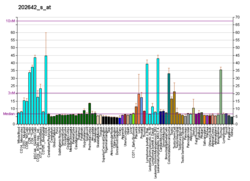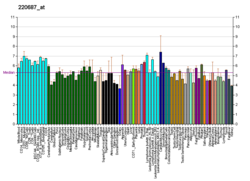(Redirected from TRRAP )
Protein-coding gene in the species Homo sapiens
TRRAP Identifiers Aliases TRRAP , PAF350/400, PAF400, STAF40, TR-AP, Tra1, transformation/transcription domain associated protein, DEDDFA, DFNA75External IDs OMIM : 603015 ; MGI : 2153272 ; HomoloGene : 39246 ; GeneCards : TRRAP ; OMA :TRRAP - orthologs Gene location (Mouse ) Chr. Chromosome 5 (mouse) Band 5|5 G2 Start 144,704,542 bp End 144,796,588 bp
RNA expression patternBgee Human Mouse (ortholog)Top expressed in ventricular zone sural nerve ganglionic eminence anterior pituitary buccal mucosa cell skin of thigh testicle stromal cell of endometrium right hemisphere of cerebellum granulocyte
Top expressed in yolk sac Rostral migratory stream ventricular zone internal carotid artery neural layer of retina anterior amygdaloid area stroma of bone marrow maxillary prominence mandibular prominence nucleus accumbens
More reference expression data
BioGPS
Wikidata
Transformation/transcription domain-associated protein , also known as TRRAP , is a protein that in humans is encoded by the TRRAP gene . TRRAP belongs to the phosphatidylinositol 3-kinase-related kinase protein family.
Function
TRRAP is an adaptor protein , which is found in various multiprotein chromatin complexes with histone acetyltransferase activity (HAT), which in turn is responsible for epigenetic transcription activation. TRRAP has a central role in MYC (c-Myc) transcription activation, and also participates in cell transformation by MYC. It is required for p53/TP53 -, E2F1 -, and E2F4 -mediated transcription activation. It is also involved in transcription activation mediated by the adenovirus E1A, a viral oncoprotein that deregulates transcription of key genes.
TRRAP is also required for the mitotic checkpoint and normal cell cycle progression. The MRN complex (composed of MRE11 , RAD50 , and NBS1 ) is involved in the detection and repair of DNA double-strand breaks (DSBs). TRRAP associates with the MRN complex and when TRRAP is removed, the complex shows reduced cDNA end-joining activity. Hence, TRRAP may function as a link between DSB repair and chromatin remodeling.
Interactions
Transformation/transcription domain-associated protein has been shown to interact with:
References
^ GRCh38: Ensembl release 89: ENSG00000196367 – Ensembl , May 2017
^ GRCm38: Ensembl release 89: ENSMUSG00000045482 – Ensembl , May 2017
"Human PubMed Reference:" . National Center for Biotechnology Information, U.S. National Library of Medicine ."Mouse PubMed Reference:" . National Center for Biotechnology Information, U.S. National Library of Medicine .^ McMahon SB, Van Buskirk HA, Dugan KA, Copeland TD, Cole MD (August 1998). "The novel ATM-related protein TRRAP is an essential cofactor for the c-Myc and E2F oncoproteins" . Cell . 94 (3): 363–74. doi :10.1016/S0092-8674(00)81479-8 . PMID 9708738 . S2CID 17693834 .
Vassilev A, Yamauchi J, Kotani T, Prives C, Avantaggiati ML, Qin J, Nakatani Y (December 1998). "The 400 kDa subunit of the PCAF histone acetylase complex belongs to the ATM superfamily" . Mol. Cell . 2 (6): 869–75. doi :10.1016/S1097-2765(00)80301-9 . PMID 9885574 .
Murr R, Vaissière T, Sawan C, Shukla V, Herceg Z (August 2007). "Orchestration of chromatin-based processes: mind the TRRAP". Oncogene . 26 (37): 5358–72. doi :10.1038/sj.onc.1210605 . PMID 17694078 . S2CID 22598445 .
Robert F, Hardy S, Nagy Z, Baldeyron C, Murr R, Déry U, Masson JY, Papadopoulo D, Herceg Z, Tora L (January 2006). "The Transcriptional Histone Acetyltransferase Cofactor TRRAP Associates with the MRN Repair Complex and Plays a Role in DNA Double-Strand Break Repair" . Mol. Cell. Biol . 26 (2): 402–12. doi :10.1128/MCB.26.2.402-412.2006 . PMC 1346889 . PMID 16382133 .
Herceg Z, Wang ZQ (March 2005). "Rendez-vous at mitosis: TRRAPed in the chromatin" . Cell Cycle . 4 (3): 383–7. doi :10.4161/cc.4.3.1546 . PMID 15711126 .
^ Park J, Wood MA, Cole MD (March 2002). "BAF53 forms distinct nuclear complexes and functions as a critical c-Myc-interacting nuclear cofactor for oncogenic transformation" . Mol. Cell. Biol . 22 (5): 1307–16. doi :10.1128/mcb.22.5.1307-1316.2002 . PMC 134713 . PMID 11839798 .
^ Fuchs M, Gerber J, Drapkin R, Sif S, Ikura T, Ogryzko V, Lane WS, Nakatani Y, Livingston DM (August 2001). "The p400 complex is an essential E1A transformation target" . Cell . 106 (3): 297–307. doi :10.1016/s0092-8674(01)00450-0 . PMID 11509179 . S2CID 15634637 .
^ McMahon SB, Wood MA, Cole MD (January 2000). "The essential cofactor TRRAP recruits the histone acetyltransferase hGCN5 to c-Myc" . Mol. Cell. Biol . 20 (2): 556–62. doi :10.1128/mcb.20.2.556-562.2000 . PMC 85131 . PMID 10611234 .
^ Liu X, Tesfai J, Evrard YA, Dent SY, Martinez E (May 2003). "c-Myc transformation domain recruits the human STAGA complex and requires TRRAP and GCN5 acetylase activity for transcription activation" . J. Biol. Chem . 278 (22): 20405–12. doi :10.1074/jbc.M211795200 . PMC 4031917 . PMID 12660246 .
^ Martinez E, Palhan VB, Tjernberg A, Lymar ES, Gamper AM, Kundu TK, Chait BT, Roeder RG (October 2001). "Human STAGA complex is a chromatin-acetylating transcription coactivator that interacts with pre-mRNA splicing and DNA damage-binding factors in vivo" . Mol. Cell. Biol . 21 (20): 6782–95. doi :10.1128/MCB.21.20.6782-6795.2001 . PMC 99856 . PMID 11564863 .
Further reading
Herceg Z, Wang ZQ (2006). "Rendez-vous at mitosis: TRRAPed in the chromatin" . Cell Cycle . 4 (3): 383–7. doi :10.4161/cc.4.3.1546 . PMID 15711126 . Murr R, Vaissière T, Sawan C, Shukla V, Herceg Z (2007). "Orchestration of chromatin-based processes: mind the TRRAP". Oncogene . 26 (37): 5358–72. doi :10.1038/sj.onc.1210605 . PMID 17694078 . S2CID 22598445 . McMahon SB, Van Buskirk HA, Dugan KA, Copeland TD, Cole MD (1998). "The novel ATM-related protein TRRAP is an essential cofactor for the c-Myc and E2F oncoproteins" . Cell . 94 (3): 363–74. doi :10.1016/S0092-8674(00)81479-8 . PMID 9708738 . S2CID 17693834 . Vassilev A, Yamauchi J, Kotani T, Prives C, Avantaggiati ML, Qin J, Nakatani Y (1999). "The 400 kDa subunit of the PCAF histone acetylase complex belongs to the ATM superfamily" . Mol. Cell . 2 (6): 869–75. doi :10.1016/S1097-2765(00)80301-9 . PMID 9885574 . Brand M, Yamamoto K, Staub A, Tora L (1999). "Identification of TATA-binding protein-free TAFII-containing complex subunits suggests a role in nucleosome acetylation and signal transduction" . J. Biol. Chem . 274 (26): 18285–9. doi :10.1074/jbc.274.26.18285 . PMID 10373431 . McMahon SB, Wood MA, Cole MD (2000). "The Essential Cofactor TRRAP Recruits the Histone Acetyltransferase hGCN5 to c-Myc" . Mol. Cell. Biol . 20 (2): 556–62. doi :10.1128/MCB.20.2.556-562.2000 . PMC 85131 . PMID 10611234 . Ikura T, Ogryzko VV, Grigoriev M, Groisman R, Wang J, Horikoshi M, Scully R, Qin J, Nakatani Y (2000). "Involvement of the TIP60 histone acetylase complex in DNA repair and apoptosis" . Cell . 102 (4): 463–73. doi :10.1016/S0092-8674(00)00051-9 . PMID 10966108 . S2CID 18047169 . Brand M, Moggs JG, Oulad-Abdelghani M, Lejeune F, Dilworth FJ, Stevenin J, Almouzni G, Tora L (2001). "UV-damaged DNA-binding protein in the TFTC complex links DNA damage recognition to nucleosome acetylation" . EMBO J . 20 (12): 3187–96. doi :10.1093/emboj/20.12.3187 . PMC 150203 . PMID 11406595 . Lee YJ, Chung TS, Yoon YS, Lee MS, Han SH, Seong GJ, Ahn KJ (2001). "The role of functional MR imaging in patients with ischemia in the visual cortex" . American Journal of Neuroradiology . 22 (6): 1043–9. PMC 7974786 . PMID 11415895 . Lang SE, McMahon SB, Cole MD, Hearing P (2001). "E2F transcriptional activation requires TRRAP and GCN5 cofactors" . J. Biol. Chem . 276 (35): 32627–34. doi :10.1074/jbc.M102067200 . PMID 11418595 . Park J, Kunjibettu S, McMahon SB, Cole MD (2001). "The ATM-related domain of TRRAP is required for histone acetyltransferase recruitment and Myc-dependent oncogenesis" . Genes Dev . 15 (13): 1619–24. doi :10.1101/gad.900101 . PMC 312730 . PMID 11445536 . Fuchs M, Gerber J, Drapkin R, Sif S, Ikura T, Ogryzko V, Lane WS, Nakatani Y, Livingston DM (2001). "The p400 complex is an essential E1A transformation target" . Cell . 106 (3): 297–307. doi :10.1016/S0092-8674(01)00450-0 . PMID 11509179 . S2CID 15634637 . Martinez E, Palhan VB, Tjernberg A, Lymar ES, Gamper AM, Kundu TK, Chait BT, Roeder RG (2001). "Human STAGA Complex Is a Chromatin-Acetylating Transcription Coactivator That Interacts with Pre-mRNA Splicing and DNA Damage-Binding Factors In Vivo" . Mol. Cell. Biol . 21 (20): 6782–95. doi :10.1128/MCB.21.20.6782-6795.2001 . PMC 99856 . PMID 11564863 . Park J, Wood MA, Cole MD (2002). "BAF53 Forms Distinct Nuclear Complexes and Functions as a Critical c-Myc-Interacting Nuclear Cofactor for Oncogenic Transformation" . Mol. Cell. Biol . 22 (5): 1307–16. doi :10.1128/MCB.22.5.1307-1316.2002 . PMC 134713 . PMID 11839798 . Nikiforov MA, Chandriani S, Park J, Kotenko I, Matheos D, Johnsson A, McMahon SB, Cole MD (2002). "TRRAP-Dependent and TRRAP-Independent Transcriptional Activation by Myc Family Oncoproteins" . Mol. Cell. Biol . 22 (14): 5054–63. doi :10.1128/MCB.22.14.5054-5063.2002 . PMC 139788 . PMID 12077335 . Ard PG, Chatterjee C, Kunjibettu S, Adside LR, Gralinski LE, McMahon SB (2002). "Transcriptional Regulation of the mdm2 Oncogene by p53 Requires TRRAP Acetyltransferase Complexes" . Mol. Cell. Biol . 22 (16): 5650–61. doi :10.1128/MCB.22.16.5650-5661.2002 . PMC 133988 . PMID 12138177 . Cavusoglu N, Brand M, Tora L, Van Dorsselaer A (2003). "Novel subunits of the TATA binding protein free TAFII-containing transcription complex identified by matrix-assisted laser desorption/ionization-time of flight mass spectrometry following one-dimensional gel electrophoresis". Proteomics . 3 (2): 217–23. doi :10.1002/pmic.200390030 . PMID 12601814 . S2CID 6035986 . Liu X, Tesfai J, Evrard YA, Dent SY, Martinez E (2003). "c-Myc transformation domain recruits the human STAGA complex and requires TRRAP and GCN5 acetylase activity for transcription activation" . J. Biol. Chem . 278 (22): 20405–12. doi :10.1074/jbc.M211795200 . PMC 4031917 . PMID 12660246 . Categories :
Transformation/transcription domain-associated protein
Add topic
Text is available under the Creative Commons Attribution-ShareAlike License. Additional terms may apply.
**DISCLAIMER** We are not affiliated with Wikipedia, and Cloudflare.
The information presented on this site is for general informational purposes only and does not constitute medical advice.
You should always have a personal consultation with a healthcare professional before making changes to your diet, medication, or exercise routine.
AI helps with the correspondence in our chat.
We participate in an affiliate program. If you buy something through a link, we may earn a commission 💕
↑






